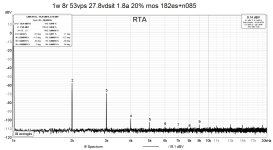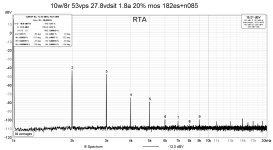if increase base current of the 182,does is can improve the output power?
clarify
I mean, if I need more strong outpout power, like 50 watts at 8 ohms, can I increase the base current of the SIT to achieve it?like 3A?
Happy holidays to all. I had a very good past few days reviving this SIT-NMUFF amplifier project.
The SIT-NMUFF now sings a sweet song. It is very different from any other amplifier that I have experienced. I have never heard the sound of a SET amplifier, but this might be similar. Amazing detail and sound stage.
Two years ago I abandoned the SIT-NMUFF because I didn't get the amplifier "tuned" correctly. The tunings that I tried resulted in oppressive levels of second harmonic.
There are at least three degrees of freedom in the tuning process:
I am in the process of increasing the power supply rail voltages to allow higher output power with the same harmonic profile.
Here are some plots:
1W 1kHz 8R

10W 1kHz 8R

25W 1kHz 8R

The SIT-NMUFF now sings a sweet song. It is very different from any other amplifier that I have experienced. I have never heard the sound of a SET amplifier, but this might be similar. Amazing detail and sound stage.
Two years ago I abandoned the SIT-NMUFF because I didn't get the amplifier "tuned" correctly. The tunings that I tried resulted in oppressive levels of second harmonic.
There are at least three degrees of freedom in the tuning process:
- Bias current
- SIT Vds
- Mu-follower gain factor
I am in the process of increasing the power supply rail voltages to allow higher output power with the same harmonic profile.
Here are some plots:
1W 1kHz 8R
10W 1kHz 8R
25W 1kHz 8R
On the same side with you here.The SIT-NMUFF now sings a sweet song. It is very different from any other amplifier that I have experienced.
I am playing with same OS to which I added a trimmer across R2 with the cursor connected to C3-(C3- goes connected only to the cursor of the trimmer).
This lets me adjust how much the mosfet will contribute to the final gain. With 0.15R I get 43% mos contribution, lowering to 20% reduces the thd considerably.
Attachments
- Home
- Amplifiers
- Pass Labs
- The SIT NFET MUFF Mutant Power Amplifier

